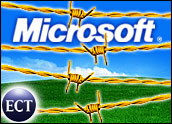
Microsoft on Thursday unveiled a predictive traffic system that combines historical traffic data with real-time updates from GPS-enabled devices in order to build real-time maps for drivers.
The services, which runs on the Live.com platform, grew out of research by Eric Horvitz, who has been working on the project for four years.
The ClearFlow system is the result of Microsoft’s application of machine learning and intelligence as it’s applied to the daily life of people. The new traffic application combines previously acquired data from 71 cities with contextual information about the area to formulate a forecast about likely traffic patterns.
It kicks in mainly when there’s a real-time problem, such as an accident on the freeway, and predicts the behavior of traffic elsewhere — such as surface streets — because of that problem, suggesting routes that won’t send you into even more traffic.
Surprise Monitoring
The software, which is based upon the JamBayes predictive traffic service, allows users to set the types of alerts — and the level of prediction — they receive.
“In operation, the surprise modeling and analysis is used to let people know when current or projected flows (both high and low) on routes that they have expressed interest in would likely surprise them,” Microsoft Research’s Eric Horvitz writes in “Machine Learning, Reasoning, and Intelligence in Daily Life: Directions and Challenges,” a research paper examining artificial intelligence and Microsoft computing.
Microsoft’s service can be accessed online or through any Internet-connected mobile device.
Tracking Traffic
Predictive traffic maps are becoming more usable because GPS-enabled devices are near ubiquitous. Inrix, which was spun out of Microsoft Research Labs and has a network of 800,000 GPS-enabled devices, gathers data for TomTom and Dash, two in-car traffic and direction services, as well as MapQuest.com.
Pulling together all of that information isn’t easy, though. The real-time, two-way communication from car to navigation system creates a complex data set that can be used to parse out specific traffic patterns.
Inrix, for instance, gathers data mainly through partnerships with commercial drivers — long-haul truckers, taxi cabs, delivery services and cable companies — along with embedded road sensors, Scott Sedlik, Inrix’s marketing vice president, told TechNewsWorld.
The company then combines that with profile information about each vehicle — cement trucks travel slower than taxi drivers, for example — to build a predictive traffic model for an area.
Emerging Patterns
These devices aren’t just for traffic, however.
Microsoft’s foray into the traffic market and other two-way navigation systems such as Dash Navigation will soon be able to provide a Web-like experience for users.
By the end of the year, the real-time traffic navigation systems will include other relevant data such as restaurant locations, hotels and businesses near a user’s location, Sedlik said.
That’s exactly the functionality that is starting to come to market now with devices like Dash,” Sedlik said. “Some will have information delivered by voice like OnStar and some will be delivered on a screen in the car.”





















































